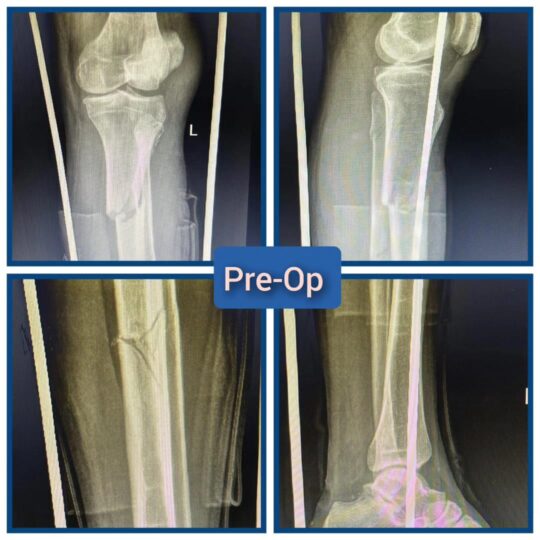Case Overview
A 40-year-old male patient sustained a significant injury after falling from a height of 12 feet. Fortunately, there were no signs of head, chest, abdomen, or spinal injuries. However, the patient was diagnosed with a floating knee, a severe injury involving fractures in both the femur and tibia.
The Injury Breakdown
1. Fracture 1: Left Segmental Femur Fracture
- Subtrochanteric fracture with a butterfly fragment: This is a fracture in the upper part of the femur near the hip. A butterfly fragment refers to a wedge-shaped fragment that often complicates the healing process.
- Extra-articular distal femur fracture: A break near the knee joint, but without affecting the joint surface.
2. Fracture 2: Left Segmental Tibia Fracture
- Proximal third tibia fracture: This is a fracture in the upper third of the tibia, the major bone in the lower leg.
- Midshaft tibia fracture: A break in the middle portion of the tibia.
Surgical Approach: Goals and Challenges
Goals:
The surgical team had three main goals for this procedure:
- Anatomical Reduction: Ensuring the bones are perfectly aligned to heal properly.
- Appropriate Stability: Achieving sufficient stability for the bones to heal while maintaining movement and weight-bearing functions.
- Respect Fracture Biology: Protecting the natural healing capacity of the bone and soft tissue by minimizing excessive handling or disruption of the blood supply.
Sequence of Fixation:
- Long Proximal Femoral Nail (PFN): The patient was positioned laterally to insert a long PFN, a type of intramedullary nail used for stabilizing femur fractures.
- Supine Position for DFLP and Tibial Plate: After stabilizing the femur, the patient was turned into a supine position to work on the distal femur and tibia. The Distal Femur Locking Plate (DFLP) was inserted using a lateral approach, with careful attention to anatomical reduction of the distal femur segment.
- Tibial Fixation with MIPPO Hockey Plate: The initial plan was to insert a nail into the tibia. However, the proximal tibia fragment was misaligning into recurvatum (backward bending) and varus (inward angulation). To counter this, the team opted for a Minimally Invasive Percutaneous Plate Osteosynthesis (MIPPO) Hockey Plate, which is ideal for stabilizing fractures while minimizing soft tissue disruption.
Duration:
This complex surgery lasted for approximately 4 hours, involving meticulous planning and execution to ensure the best possible outcome.
Conclusion
This case illustrates the intricacies involved in treating a floating knee injury. Achieving anatomical reduction, proper stabilization, and preserving the natural biology of the fracture site are all critical factors in a successful outcome. The decision to use a combination of PFN, DFLP, and MIPPO plates demonstrates the complexity of trauma surgeries and the expertise required to handle such cases.
Key Hashtags
#ComplexTrauma #FloatingKnee #FemurFracture #TibiaFracture #OrthopedicSurgery






